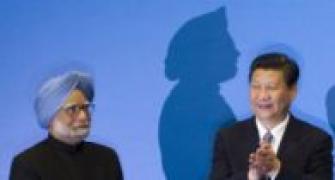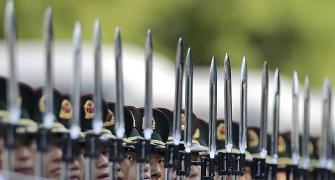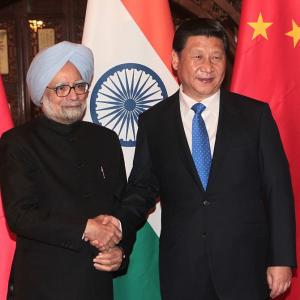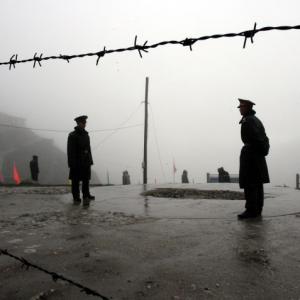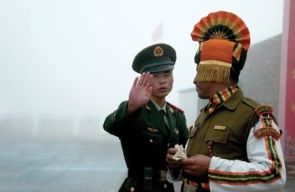 The border agreement with China is yet another dose of insidious placebos administered on the people of India by their own government that has been in perpetual denial over the steady incremental loss of strategic Indian territory, says R N Ravi.
The border agreement with China is yet another dose of insidious placebos administered on the people of India by their own government that has been in perpetual denial over the steady incremental loss of strategic Indian territory, says R N Ravi.
Dr Manmohan Singh, the most widely foreign-travelled among Indian prime ministers, is learnt to have concluded his official foreign visits in his current term as the head of government with his latest trip to Beijing from October 22-24. The seminal achievement of this visit, as being touted by his government, is the Border Defence Co-operation Agreement he signed with Li Keqiang, his Chinese counterpart, on October 23.
The agreement is being hailed as a landmark progress in the chronically troubled India-China relationship and a historic achievement of the United Progressive Alliance government towards securing India’s border with China.
An observer of India-China border relations is baffled at the banality called the BDCA and shocked at the brazenness with which a repetitive deception on India is being peddled as an important measure for safeguarding India’s territorial interests from China’s strategic belligerence.
Status quo at the Line of Actual Control between India and China is at the core of the numerous agreements and protocols signed between the two countries since 1993. However, China has not yet revealed its position on the alignment of the LOAC. India, too, for some obscure and self-defeating reasons, has not yet categorically articulated its position on the geographical alignment of the LOAC. Its failure to do so helps China enormously in sustaining its strategic belligerence at the border.
China does not bind itself by articulating its own position on the LOAC and keeps making tactical incremental territorial advances into India to achieve its strategic objectives: a) gain crucial territories in geo-strategically sensitive areas and thereby irreversibly depleting India’s strategic territorial depth imperative for its national defence vis-à-vis China; and b) severely undermine India’s covert and overt potential capabilities for adventures across the border in Tibet or Xinjiang by keeping its own border region perpetually destabilised.
There has been some shift in India-China relations in the last over two decades. Quantum jump in trade and commerce between the two countries has somewhat improved the atmospherics of the relationship. On the vexed border issue, there has been a perceptible convergence in the language of reconciliation. The two countries have signed some half a dozen agreements and protocols reiterating mutual restraint and non-aggression at the LOAC.
However, in the absence of a mutually agreed LOAC, all the agreements and protocols for maintaining the status quo are no more than mere vacuous expressions of intent that only helps the more powerful of the two. In the absence of a mutually agreed LOAC, the situation becomes all the more unredeemable for an asymmetrically placed India when it does not spell out its own perception of the LOAC.
To make matters worse for itself, India restrains its border guarding troops from patrolling its LOAC. Unlike India’s border with Pakistan where Indian troops have their posts at the Line of Control and regularly patrol the LoC, India does not allow its border guarding forces even to venture up to the LOAC. The troops are not allowed to go beyond the Line of Patrolling, a unilaterally chosen retreat position of India that runs far behind the LOAC. With no boots on the ground the Indian stance at the LOAC is militarily untenable.
China takes full advantage of this institutionalised military vacuum between the Indian LOAC and the LOP. It moves its troops forward without any resistance. China could not have asked for a better scenario when it steadily gains territory and fulfills its strategic objectives without any resistance. It is a classic illustration of winning a war without a fight, a military doctrine attributed to Sun Tzu, a Chinese military strategist.
China has already taken, post-1962 war, a fairly large tract of India’s land in the sub-sector north in Ladakh. Since 2005 and especially after 2009 it has shown enhanced belligerence in this sector and has moved its troops further deep inside the Indian territory beyond its stated claims in 1960 and what it captured in the 1962 war. It has been steadily nibbling into the Shyok valley, an area of crucial strategic significance for India, to maintain a tenable position in this sub-sector and retain its claim at the strategic Karakoram pass linking India with Xinjiang and Central Asia.
On the eastern front, in Arunachal Pradesh, during the last four years Chinese military pressure has increased manifold at strategically sensitive points on the border. Its aggressive push since 2008 in Tatu Bowl/Dichu in Anjaw district along the Lohit river is alarming. Today it dominates the only route for Indian patrols to visit the India-China-Myanmar tri-junction. Fearing a likely face-off with the Chinese, India has stopped patrolling this segment of the border.
China has, bilaterally, fixed its border with Myanmar at the Diphu Pass at the India-Myanmar border in Arunachal Pradesh, pushing the India-China-Myanmar tri-junction fixed by the McMahon Line down by over eight km. Chinese advance along the Lohit has serious adverse geo-strategic consequences for security in India’s North-East.
Ironically, the China’s military belligerence became more pronounced after India and China began talking peace and signing agreements and protocols.
The BDCA, the latest among the agreements, is repetitive in its essence and more ambivalent in its language than the previous agreements. The Agreement on the Maintenance of Peace and Tranquility Along the Line of Actual Control signed in September 1993, the first among such agreements, was far more emphatic in its intent and language than the tame and highly ambiguous BDCA. It inter alia states, ‘No side shall overstep the line of actual control’ and adds that ‘in case personnel of one side cross the line of actual control, upon being cautioned by the other side, they shall immediately pull back to their own side of the line of actual control’.
On the issue of air intrusion it categorically obligates the two countries ‘to ensure that air intrusions across the line of actual control do not take place’.
Contrast these with the corresponding clause Article II of the BDCA: ‘The two sides shall assist the other side in locating personnel… and aerial vehicles that may have crossed or are possibly in the process of crossing the line of actual control in the India-China border areas’.
Instead of pressing the Chinese for fixing the LOAC, the core interim issue pending the final settlement of border, Prime Minister Manmohan Singh returned home diluting the earlier commitments of China for non-aggression and assuring the Chinese that our troops will share sweets with their Chinese counterparts on our national days and festivals (article V, BDCA).
The BDCA is yet another dose of insidious placebos administered on the people of India by their own government that has been in perpetual denial over the steady incremental loss of strategic Indian territory. It perpetuates the dynamic status quo grossly tilted in favour of China and does not, in any way, safeguard the territorial integrity of India. Land grab by China continues. Chinese aircraft, helicopters and unmanned aerial vehicles are intruding into Indian air space in far more numbers than before.
R N Ravi is a retired special director of the Intelligence Bureau and monitored the China border for over 20 years. He can be reached at ravindra.narayan.ravi@gmail.com

